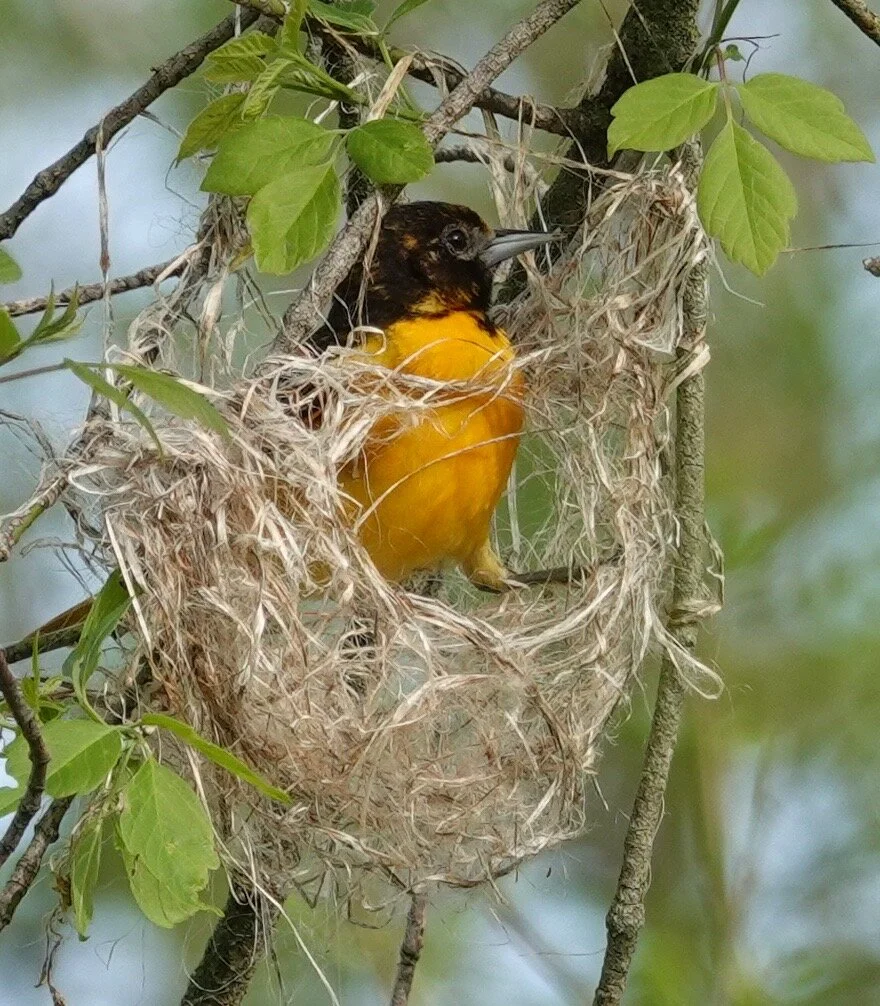Naturally
My first bird of the year was a cardinal. A white-throated sparrow found food on the ground on New Year's Day. The Christmas chipmunk joined it. The night before, I'd wondered how many stars there were in the sky.
A drive to drop off of Christmas things directed my eyes to house sparrows. They were abundant around livestock. Their numbers were greater when considerable food was available in cities because of horses. House sparrows feed on spilled grain and undigested seeds in manure.
I spotted a Baltimore oriole nest still hanging on. The female chooses the site. She generally builds the nest, a hanging pouch firmly attached to a fork of a slender branch in the upper branches of a deciduous tree (especially cottonwoods, maples and elms). It's tightly woven of plant fibers, strips of bark, grapevines, grass, yarn, string, plant down and hair.
I drove by muskrat mounds (lodges and push-ups). An old trapper told me to count lodges and multiply by five to get the muskrat population of a wetland.
While walking on a Christmas Bird Count, I saw some black knot, a widespread fungal disease that attacks trees of the genus prunus, like plum and cherry trees. The hard, uneven, black galls appear to enwrap twigs and branches. Some trees tolerate black knot while others are stunted or killed.
Voles prefer a white Christmas. They love to be under the snow for Christmas. They prosper in the subnivean zone, the area between the surface of the ground and the bottom of the snowpack. Mice and shrews also retreat there for protection from cold temperatures, bitter winds and hungry predators. Food is available there. It takes about 6 inches of snow to provide the critters with a sturdy roof and roomy living quarters. A bit more snow and the subnivean zone remains near 32° regardless of the temperature above the snow.
Q&A
A St. Peter reader asked what he should do with his bird feeders when he heads south for the winter. The best option would be to ask a kind friend, someone you can blackmail, a family member, a friendly neighbor or someone you could pay a princely sum to fill your feeders while you’re away. The good news is that your birds will do fine while you're gone. Birds adjust and they don't become dependent on a single food source. They will continue to patronize other food sources and find new ones. To prepare for your departure, slowly lessen the amount of food offered in your feeders so your avian amigos won't be shocked when they find the feeders are empty or removed. Even if you remove your feeders, the birds will come back. When you return home and have restored and filled the feeders, it might take a few days for the birds to find the food. When that happens, there is a chance of a tearful reunion. And don't worry, we, the stubborn or stupid who remain in Minnesota all winter, will continue to have nothing but good things to say about you.
"What do beavers eat?" The beaver is the largest rodent in North America weighing 40 to 70 pounds and eats bark, buds, stems, twigs, grasses, mushrooms, leaves, ferns and the roots of aquatic plants.
“How do I know what winter finches from the north might visit my yard?” The movement of some finches and other birds into Minnesota is based on the abundance of food in Canada. Pine grosbeaks might not be traveling much as the mountain ash fruit crop was good in the northern coniferous forests this winter. Pine siskins were reported at many feeding stations in 2020. They feed on spruce seeds in Canada and finch seed at our feeders. Red and white-wing crossbills feed primarily on conifer seeds. Purple finches show up most years and feed on the sunflower seeds we offer. Common redpolls (a redpoll weighs slightly more than four pennies) feed on birch and alder seeds. They eat nyjer seed at feeders. A caller said she'd spotted the largest goldfinch she'd ever seen. I want to see one of those evening grosbeaks in my yard, too. They feed on box elder, maple, ash and locust seeds. They're prodigious eaters of sunflower seeds. Red-breasted nuthatches aren’t finches but depend on conifer seeds when wintering in the north.
“Where does the name sandpiper come from?” I suspect the derivation is due to a combination of a piping cry coming from a bird on the sand.
Thanks for stopping by
"Ring out false pride in place and blood, the civic slander and the spite; ring in the love of truth and right, ring in the common love of good." — Alfred, Lord Tennyson
"There are two seasonal diversions that can ease the bite of any winter. One is the January thaw. The other is the seed catalogs." — Hal Borland
Do good.
©Al Batt 2021
A Baltimore Oriole constructing a nest. Photo by Al Batt

